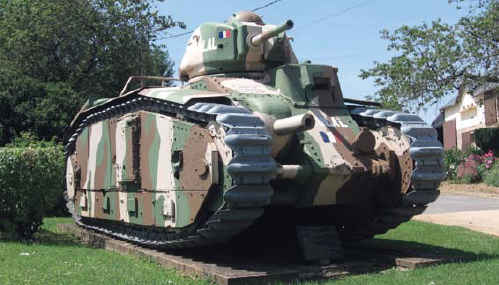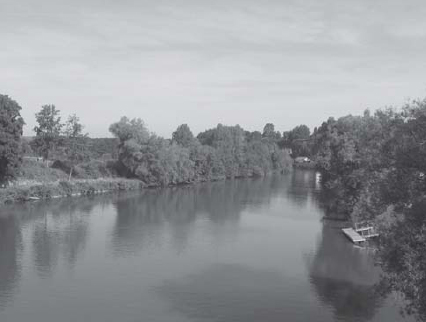
The key to the success of the Fall Gelb campaign was the battle of Sedan, 13–15 May. Visiting the battlefield today, the military historian and enthusiast will discover that while Napoleon III’s decisive defeat in 1870 and the two battles fought there in World War I are well accommodated with monuments, memorials and museums; the later defeat that cost the French the 1940 campaign – and four-and-a-half years of freedom – is not nearly so well commemorated.
The most persistent relics of the Sedan battle are the many concrete casemates still dotting the countryside, too strong to demolish except in the most profitable circumstances. For instance, driving west from Sedan towards Donchery along road D724 reveals Blockhouse 46 and Artillery Casemate 47, which were instrumental in III/147e RIF’s repulse of 2. Panzer-Division’s initial crossing attempts. Likewise, south-east of Sedan pillboxes, blockhouses and casemates dot route D6E, these having been used in I/147e RIF’s repulse of the initial assaults by both of 10. Panzer-Division’s rifle regiments. Today, these are but empty tombs dedicated to the men who died inside them.
Commemorated as such is Maison-Forte (MF10) Saint-Menges – one of eight positioned along the roads from the Semois into Sedan – which is located along the east edge of D6, about 2 miles north of the village by the same name. Additionally, it is also possible to locate the large command bunker of Général Lafontaine and his 55e DI staff, approximately a mile south of Bulson, about 150yds into the woods just south of Au Jardin de Bulson (east side of D29).

Fabricated from pieces and parts of several tanks, this Char B1 bis is a memorial guarding the crossroads in the village of Stonne. It is painted to represent Char 382 ‘Toulal’, a 49e BCC tank that fought in the vicious battle here and on the high ground to the west, while Guderian’s Panzers drove to the sea. (Author’s collection)
For all the completed defensive positions dotting the landscape south of Sedan, when one examines the frontage along the Meuse that was subjected to 1. Panzer-Division’s assaults, it is striking that northwards from Casemate 211 – easily viewable just north of the Pont Neuf bridge – there were none for over a mile to the corner of the Iges Canal. While the gunners of Casemate 211 made IRGD’s crossing costly, the two battalions of Kirchner’s SR (mot.) 1 faced only three rifle squads and a machine-gun team in open positions. The lack of meaningful resistance allowed 1. Panzer-Division’s riflemen and pioneers to cross – as Guderian described – ‘as though it were being carried out on manoeuvres’, and once afoot on the far side they were able to quickly organize a powerful advance through the widely spaced casemates forming the Ligne Principale de Résistance. Upon seeing the battlefield in detail one appreciates the possibility, had this section of the Meuse been fortified with casemates manned with resolute 147e RIF fortress troops like the rest of 55e DI’s river frontage, that the 1. Panzer-Division’s assaults could have been repulsed just as were both the Panzer divisions on its flanks.
The observant viewer is also struck by the very restricted fields of fire – narrow arcs and the limited range of their weapons – provided by gunners ensconced in the widely separated casemates, and thus the necessity of the interval troops, the ones that panicked and fled. In their absence, it is easy to see how the German riflemen were able to infiltrate between and around the concrete casemates and eliminate one after another by attacking from their blind sides.
While there are few memorials to the May 1940 combats in the vicinity of Sedan, further south, beginning at Stonne, memorials and monuments to the stout defence presented by the many component units of the 3e DCr and 3e DIM abound – even though that battle proved irrelevant to the outcome of the Fall Gelb campaign. Nevertheless, the displays at Stonne provide the viewer with an up-close look at a well-maintained Char B1 bis tank – its armour marred but unpierced by several noticeable enemy hits – and an APX 47mm SA 37 anti-tank gun. At Sy – the location of the HQ for the 3e DIM’s artillery regiments – can be seen a modernized Model 1897/1935 75mm cannon. These and other pertinent sights are well organized along the ‘Bataille de Stonne Circuit Historique’ route.

North of Pont-Neuf in Sedan, the Meuse now flows peacefully. The bunker visible above the riverbank to the far left (between the first two trees) is Casemate 211, from which determined defenders initially held off the elite IRGD. However, because there were no other defences for the next 1.75 miles, beyond the bend in the distance SR (mot.) 1’s crossing went ‘as though … on manoeuvres’. (Author’s collection)
While the museum in the famous ‘Château Fort de Sedan’ contains nothing pertaining to the May 1940 battle, numerous small museums in the Sedan area can be recommended. These include Museum May 1940 in Margut, the Spahi Museum at La Horgne, the Museum of Battle May–June 1940 at Semuy, and the Maginot Line fort at Villy-La-Ferté.